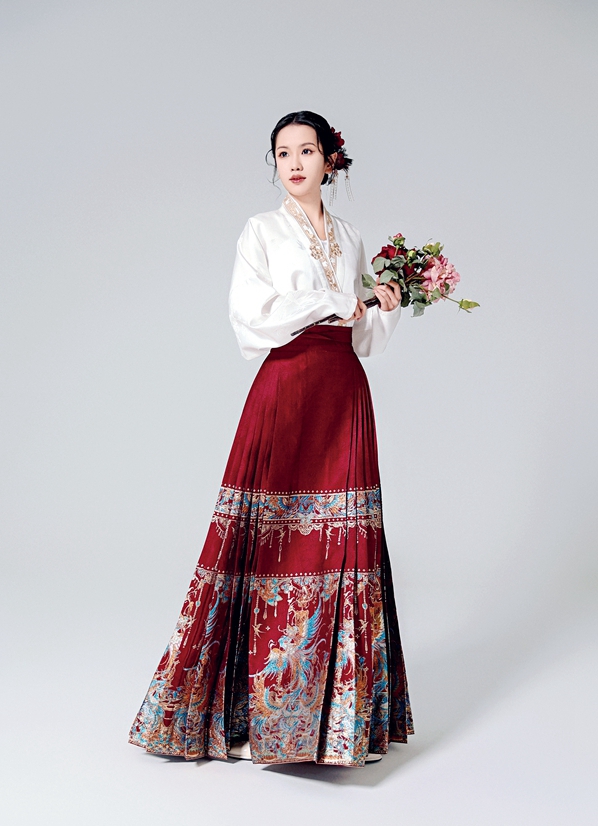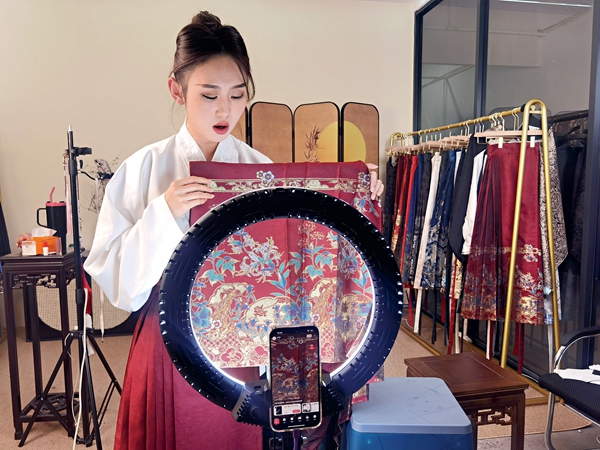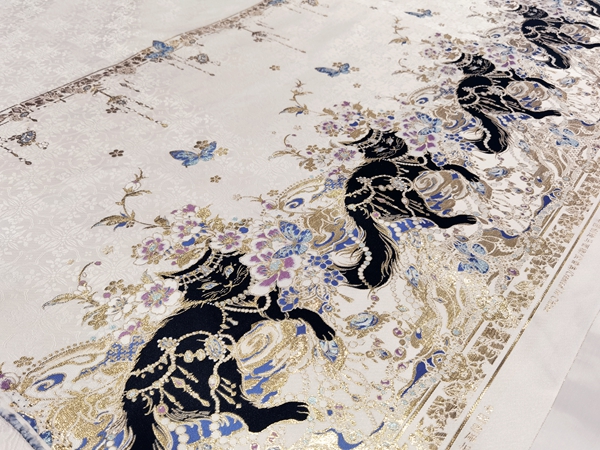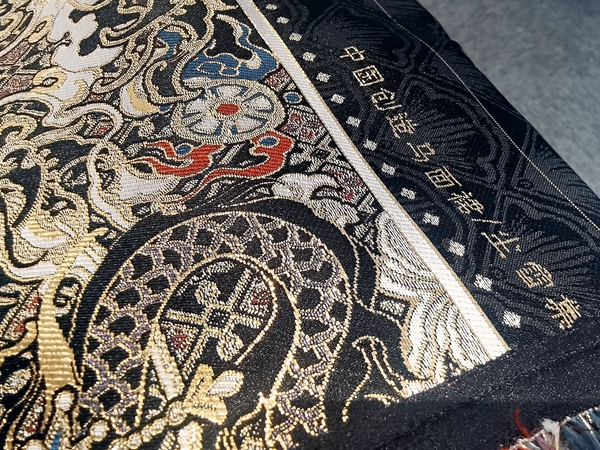'Created in China'
Popularity of Mamianqun Reveals Country's Confidence in Fine, Traditional Culture
 |
| Liu Wenyue wears Mamianqun she designed. [Photo from Liu Wenyue] |
Mamianqun, which literally translates to "horse-faced skirt," is a type of traditional Chinese attire that has exploded in popularity across China, especially since the beginning of this year. Many bloggers and celebrities, who have hordes of online followers, like to share pictures and/or videos of themselves wearing such skirts while visiting historical attractions and/or tourist hotspots. The increasing popularity of Mamianqun has raised public enthusiasm for fine traditional Chinese culture. More and more people are vowing to play their roles in the protection and inheritance of traditional Chinese clothing.
 |
| Liu Wenyue is a Hanfu designer who was born in 2000. [Photo from Liu Wenyue] |
Business Opportunities
Mamianqun originated more than 1,000 years ago, during the Song Dynasty (960-1279). The clothing gained popularity, particularly among women, during the later Ming (1368-1644) and Qing (1616-1911) dynasties. The pleats and panels of the skirt resemble ancient defense turrets protruding from walls. Such turrets were called "mamian." The skirt was designed to be worn while riding; therefore, the pleats are not only decorative, they are also designed to allow for free movement.
Given the increasing popularity of Mamianqun, since the latter half of last year, clients from textile-manufacturing plants, nationwide, have visited Xucun, a town in Haining, a city in East China's Zhejiang Province, in search of jacquard fabric, the major raw material used to make the skirts. Xucun has become known as one of China's largest production bases and sales centers of jacquard fabric.
Shen Juhua is vice-manager of a textile company in Xucun. He recalls, during the Spring Festival earlier this year, he and his wife saw more than 30 tourists dressed in Mamianqun in a 20-minute period while they were visiting West Lake, in Hangzhou, capital of Zhejiang.
 |
| An anchor livestreaming Mamianqun designed by Liu Wenyue [Photo by Jiang Yutong] |
An industry insider once told Shen only a small number of people would wear Mamianqun as part of their daily attire, because the skirts were too heavy and not suitable for contemporary work and life occasions.
Shen's company, and most other textile companies in Xucun, mainly produced curtains in previous years. However, Shen says his company has been receiving orders for the fabric used to make Mamianqun since the latter half of last year. The company purchased additional manufacturing machines — 24 in September and another 18 in November — to keep up with the orders for jacquard fabric, and for some of the other raw materials used to make the skirts.
In fact, virtually every relevant company in Xucun enlarged its production capacity to take advantage of the business opportunity. Fabric makers in Xucun are expected to purchase approximately 1,000 manufacturing machines, combined, this year, to increase earnings from the production of raw materials used to make Mamianqun.
Wang Chao heads another textile company in Xucun, and his company entered the Mamianqun market earlier than other companies in the town. Prior to 2022, only a small number of people — primarily those who loved to wear traditional Chinese clothing — knew about and wore Mamianqun, Wang says. Now, jacquard fabric and Mamianqun-related garments are the highlight of his company's exhibition venue.
Designer's Story
Liu Wenyue is a Hanfu designer. She has designed more than 400 sets of Han costumes, the traditional Chinese clothing widely known as Hanfu. She was born in 2000. Her hometown is Songyang, a county in Lishui, a city in Zhejiang.
During her childhood, Liu often wore clothes handed down from her older sisters, and then she passed the clothes down to her younger sisters. Instead of becoming a teacher, the career path her parents hoped she would choose, Liu studied Hanfu designing, and she eventually became a clothing designer.
 |
| A cat-patterned Mamianqun [Photo by Jiang Yutong] |
Liu recalls how she saved enough money to buy a set of Hanfu, for the first time, when she was in senior high school. She practiced designing Hanfu, and her work was purchased by a clothes seller for 300 yuan (US $41.67). The seller also gave Liu some professional advice, including telling her to draw her designs on a computer.
Liu continued designing Hanfu while studying in college, even though her major was preschool education. Gradually, her client list grew. After she graduated from college, Liu accumulated sufficient experience to start her own business. In July 2023, Liu moved her company from Lishui to Xucun, so she would have an easier time obtaining raw materials.
Earlier this year, Liu, who was born in the Year of Dragon, fulfilled her dream of wearing a self-designed Mamianqun, decorated with patterns of Loong (Chinese dragon). Her newly designed skirt was inspired by sunk panels, a classic form of decoration on ceilings of traditional Chinese architecture. Liu says the design has become a top seller.
Intangible cultural heritage is an important source from which Liu gets inspiration when she is designing traditional Chinese clothes. She has also made an effort to combine classic patterns with the modern elements today's youth tend to appreciate. For instance, many young people raise cats as pets. Liu has three cats. She has designed two series of Mamianqun with cat patterns.
 |
| Fabric woven with the Chinese characters that mean "Mamianqun created in China" [Photo by Jiang Yutong] |
Adapting
An exhibition hall in Haining showcases textile-related intangible cultural heritage. Items highlighting a wide range of textile-related intangible cultural heritage, originating from various places across the country, are on display.
Managers of the exhibition hall have strengthened cooperation with the China Academy of Art, based in Zhejiang, and various universities in the province, such as Zhejiang Sci-Tech University, to develop crafts, and especially, the designing and manufacturing of raw materials used to make Mamianqun.
The popularity of Mamianqun reveals the rise of "guochao," which is known also as "China chic." Guochao incorporates traditional Chinese cultural and/or art designs with products involving clothing, food and other daily necessities. Both Mamianqun manufacturers and designers agree guochao has been an unstoppable trend.
During the past decade, China has witnessed a surge in consumers'interest in this trend. It is widely believed there are bright market prospects for guochao products, as long as designers and producers continue adapting to changes within the trend.
As a young designer, Liu says all of her horse-faced skirts contain the fabric woven with the Chinese characters that mean "Mamianqun created in China." Since this style of skirt originated in ancient China, and as the skirts are mainly designed and produced in China, Mamianqun represents a fashion "created in China," Liu concludes.
(Women of China English Monthly May 2024)
Editor: Wang Shasha
Please understand that womenofchina.cn,a non-profit, information-communication website, cannot reach every writer before using articles and images. For copyright issues, please contact us by emailing: website@womenofchina.cn. The articles published and opinions expressed on this website represent the opinions of writers and are not necessarily shared by womenofchina.cn.








.jpg)

 WeChat
WeChat Weibo
Weibo 京公网安备 11010102004314号
京公网安备 11010102004314号